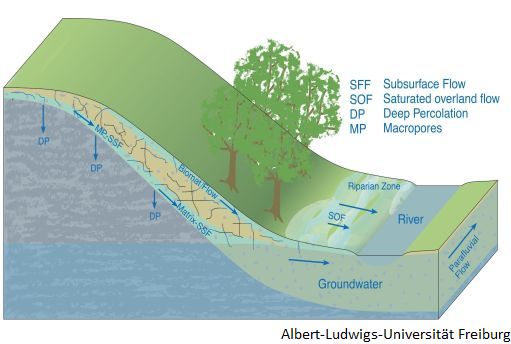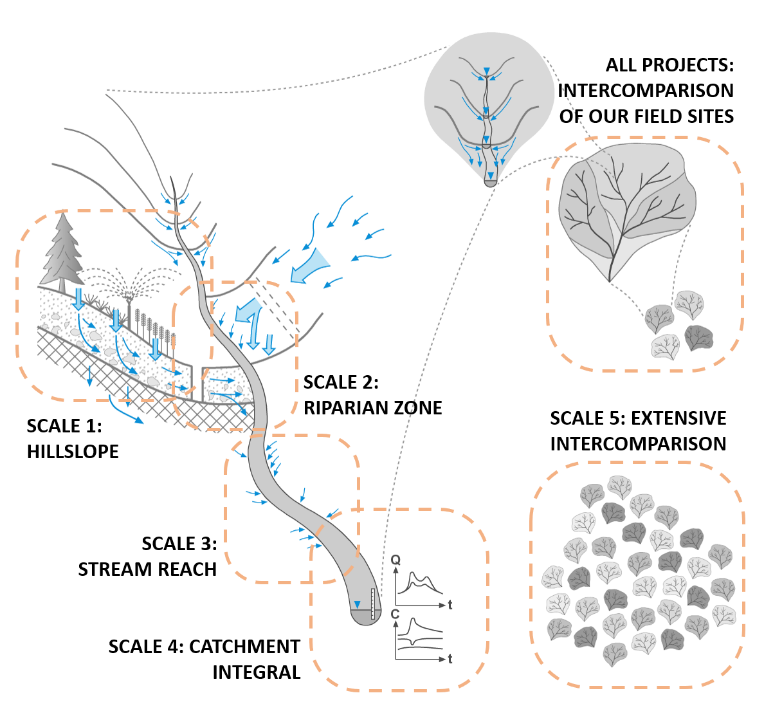SSF Fast and invisible : Conquering Subsurface Stormflow through an Interdisciplinary Multi-site Approach [funded by DFG]
Projektmitglieder:
Jadzia Witt
Programmbeschreibung:
What is Subsurface Stormflow (SSF) ?

“SSF is a direct subsurface response to a precipitation event, contributing to streamflow generation. SSF is thus all subsurface flow reaching the stream during an event, including near-stream saturation-excess overland flow triggered by SSF and return flow. (DFG-funded scientific network “Subsurface stormflow” (Chifflard et al. 2019))
Generally, SSF develops in vertical structured soils where the bedrock or a less permeable soil layer is overlaid by a permeable soil layer and vertically percolating water is deflected more or less in a lateral downslope direction due to the slope inclination (e.g., Rinderer et al. 2017, Blume & van Meerveld 2015, Rinderer et al. 2014, Moldenhauer et al. 2013, Bachmair & Weiler, 2011). Subsurface flow can also occur when groundwater levels rise into more permeable layers and water flows laterally through the more permeable layers to the stream (“transmissivity feedback mechanism”; Bishop et al. 1990).

Main questions
Where does water go when it rains?
Where are floods generated and how?
What controls stream water quality during events?
These questions are important to many fields from engineering and flood protection to water and ecosystem management and prediction of impacts of global change. The most elusive processes in the process-ensemble underlying these questions is subsurface stormflow (SSF), the fast event response triggered by lateral subsurface flow. SSF is prevalent and a more important process than generally accounted for because a basic understanding based on systematic studies across scales and sites is still lacking. However, only with systematic studies will it be possible to really advance our understanding by discovering general principles of SSF functioning and to provide protocols and best practices for its assessment, both experimentally and with respect to modelling. In many natural landscapes, SSF, i.e. any subsurface flow that occurs in response to a precipitation event, plays a major role in runoff generation: either by contributing directly to streamflow or by producing saturated areas or return flow, which then is the underlying cause of saturation excess overland flow. Therefore, much of what we see as event response in the hydrograph might be the direct or indirect result of SSF. It is likely that the discharge signal of SSF, including the indirectly triggered response in the stream, is larger than we generally assume. While its importance is probably largest in the headwaters, headwaters make up 70% of the stream network and greatly influence the supply and transport of water and solutes downstream. However, SSF is elusive and poorly accounted for as measurements are difficult for several reasons: the inaccessibility of the subsurface, the large spatial variability and heterogeneity, the variable sources and the fact that it is a threshold-driven process that only occurs during certain events. Thus, systematic studies of SSF are lacking, mainly due to difficulties of quantification. We suggest such a systematic study of SSF in different environments, across scales, and using a well-designed and replicated selection of approaches including novel approaches. This will be followed by a systematic evaluation of methods and possible proxies as well as model intercomparison, evaluation and improvement.
The overall objective is to focus on a thorough and systematic investigation of SSF across sites and scales, which requires work on four challenges
Challenge 1: Development of novel experimental designs and methodologies from the hillslope to the regional scale Specific aims for this challenge include
a) the development of a systematic experimental design for the investigation of SSF as well as its controls: combining multiple methods covering multiple scales at multiple sites,
b) the identification of proxies/signatures of SSF,
c) the assessment of measurement uncertainties and finally
d) the development of an experimental protocol (best practice) for SSF measurement and assessment.
Challenge 2: Spatial Patterns of SSF (Identification, characterization and prediction) This applies to both ex-perimental work as well as modeling. For the experimental side aims are based on the systematic inter-site comparisons and include
a) assessing how surface and subsurface structures affect SSF,
b) assessing the importance of the riparian zone as a potential gatekeeper of SSF contributions to streamflow,
c) closing observation gaps between the hillslope and the catchment scale to provide insights on distributed hillslope-stream connectivity at the larger scale,
d) developing hydrograph-based signatures of SSF that enable assessment of SSF occurrence at larger scale.
On the modeling side, we will benchmark the performance of different spatially distributed models in simulating spatial SSF patterns (1) by using readily available information like discharge observations or soil maps and (2) by using the newly collected experimental information on spatial SSF occurrence at our study sites. Consequently, the model benchmarking will provide new insights on the limits of parameterizing SSF processes with typically available data and on the potential of SSF specific data collection to improve SSF simulations.
Challenge 3: Thresholds and Cascading Effects of SSF (Identification, characterization and prediction) The specific aims of this challenge include
a) monitoring the dynamics of subsurface connectivity: threshold identification acrossscales,
b) feedback of SSF generating saturation overlandflow,
c) generationoffrequency distributions of SSF occurrence across scales and
d) benchmarking the performance of lumped and spatially distributed models in reproducing SSF threshold behavior at the catchment scale using readily available data
and the newly collected data of this project.
For the latter, new methods to include the highly resolved experimental data obtained at different scales into model parameterization and calibration will be developed.
Challenge 4: Impact of SSF (Identification, characterization and prediction)
A thorough testing of the effects of SSF includes
a) the assessment of SSF effects on transit time distributions and young/old water fractions, velocity vs celerity,
b) the assessment of dissolved matter export as a result of SSF including nutrients, DOC, and weathering products,
c) an impact assessment across scales: at what scale is SSF most relevant for floods, water storage and export of matter?
All of these aims will be pursued based on experimental work
and modeling (including model inter-comparison). On the predictions side, we will furthermore explore how spatial patterns and thresholds of SSF change under different climate conditions. Increasing rainfall intensities in winter may increase SSF abundance at the hillslope scale but will this change still be recognizable at the catchmentscale? Applyingbdifferent alterations to the observed climate, we will show when and how much SSF changes induced by climatic variability affect the flood occurrence and catchment storage at the catchment scale of our different study sites.
Whereas standard single research projects investigate part of this puzzle at a specific location, this Research Unit provides the unique opportunity of fitting a large number of puzzle pieces together. This Research Unit will have a strong emphasis on experimental work in four different test catchments that then directly feeds into a collaborative modelling effort, which in turn influences experimental design in an iterative process.
